Journey Through Time: Exploring the Historic Monasteries of Ireland
Ireland boasts a wealth of remarkable monastic sites, each telling a unique story of the country's illustrious past and deep-rooted spirituality. Embarking on these historical routes and visiting these sacred places offers heritage travelers an enriching experience, connecting them with Ireland's vibrant history and the spiritual essence of bygone eras.
The British Isles' first monastic foundations were established in Ireland, predating even St. Patrick's arrival in 433 AD. Following the introduction of Christianity in the fifth century, the subsequent centuries witnessed a proliferation of monastic communities across the Emerald Isle. These monasteries flourished, evolving into influential hubs of culture, politics, and trade, shaping Ireland's identity and landscape until the twelfth-century Anglo-Norman invasions. Despite the absence of a centralized authority, these monastic centers thrived as bustling urban communities, fostering learning, craftsmanship, and religious devotion, leaving an indelible mark on Ireland's cultural tapestry.
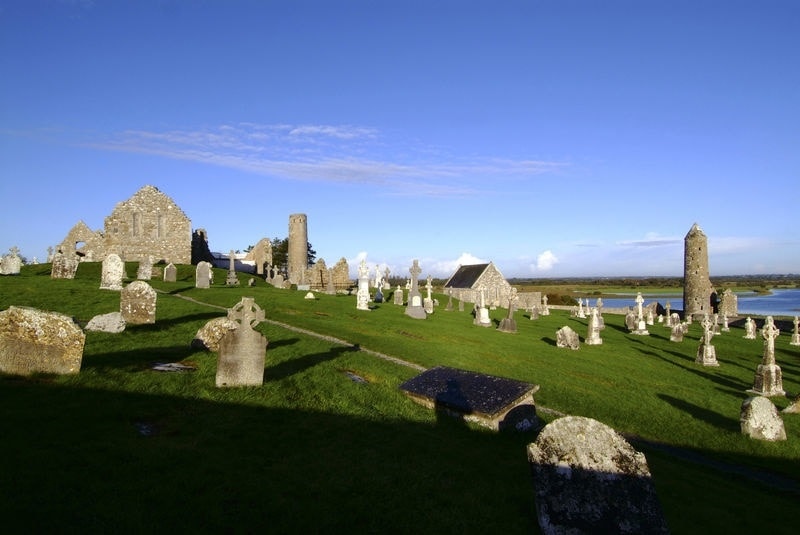
Clonmacnoise, Co. Offaly
Situated majestically on the banks of the River Shannon, Clonmacnoise stands as one of Ireland's most pristine and historically significant monastic sites. Founded by St. Ciaran in the sixth century, this revered monastery is a testament to Ireland's rich Christian heritage and spiritual legacy.
Clonmacnoise is renowned for its exquisite High Crosses, with the Cross of the Scriptures standing out for its intricate carvings depicting biblical scenes, including the Crucifixion and the Last Judgement. Additionally, the monastery boasts two iconic round towers and the hauntingly beautiful ruins of six churches, each echoing tales of a bygone era.
Despite facing multiple attacks and plundering over the centuries, Clonmacnoise remained a beacon of Christian faith and cultural significance from 545 AD until its unfortunate despoliation in 1552. Today, this historic site continues to draw pilgrims and history enthusiasts alike, who journey to County Offaly to delve into its compelling history and explore its ancient ruins. The monastery's captivating past is vividly brought to life at the modern Interpretive Centre, offering visitors a deeper understanding and appreciation of Clonmacnoise's enduring legacy.
Overnight: Ballyfin Demesne, Co. Laois or Wineport Lodge, Co. Westmeath
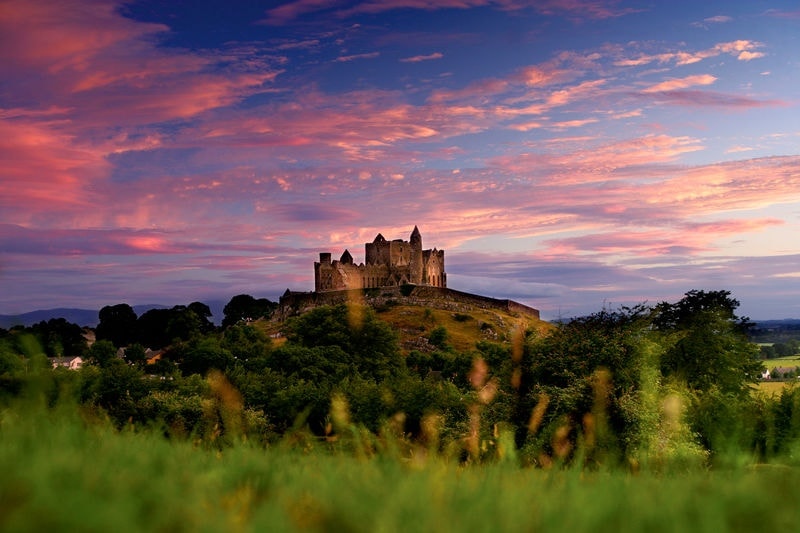
Rock of Cashel, Co. Tipperary
Perched atop a limestone outcrop in the picturesque Golden Vale, the Rock of Cashel stands as one of Ireland's most breathtaking and historically rich landmarks. This awe-inspiring site boasts a remarkable collection of medieval buildings, each echoing tales of bygone eras and showcasing the country's vibrant architectural and cultural heritage.
Visitors to the Rock of Cashel can marvel at the intricate details of the twelfth-century round tower, the exquisite High Crosses, and the beautifully preserved Romanesque Chapel. The thirteenth-century Gothic Cathedral offers a glimpse into the grandeur of medieval craftsmanship, while the fifteenth-century castle and the meticulously restored Hall of Vicars Choral provide insights into the region's turbulent history and the lives of its inhabitants.
Immerse yourself in the captivating allure of the Rock of Cashel, where history comes alive amidst stunning natural surroundings, creating a truly unforgettable experience for history enthusiasts and travelers alike.
Overnight: Cashel Palace Hotel
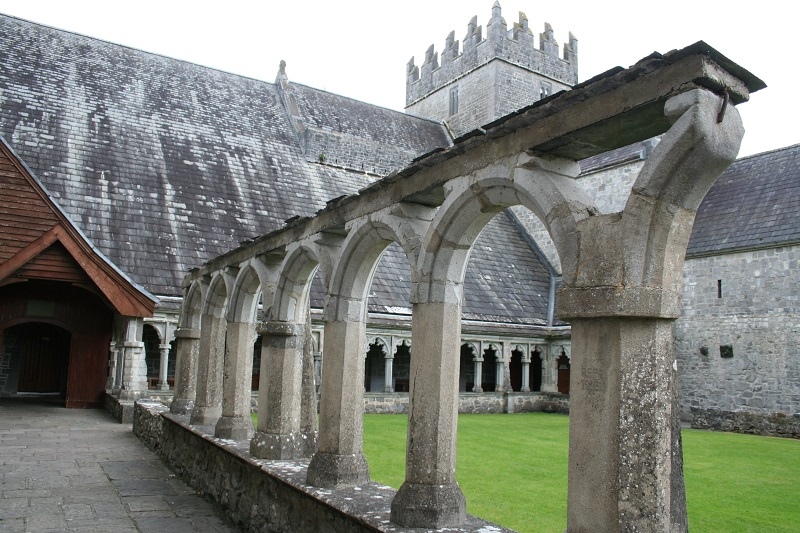
Holy Cross Abbey, Co. Tipperary
Nestled in the serene landscapes of County Tipperary, Holycross Abbey holds a special place in Ireland's spiritual history as a revered pilgrimage site. This historic abbey became widely known during the Middle Ages, thanks to the presence of one of the earliest relics of the True Cross – believed to be a physical part of the cross upon which Jesus Christ was crucified.
Gifted to the abbey in the twelfth century, this sacred relic attracted countless pilgrims seeking spiritual solace and divine blessings. Despite the abbey's dissolution in 1538 and the subsequent preservation of the relic elsewhere, its profound significance endured through the ages. Now, centuries later, the cherished relic has returned to its original home at Holycross Abbey, where it is joined by a second similar relic, reigniting the abbey's status as a prominent pilgrimage destination.
Today, the tranquil cloister of Holycross Abbey has once again become a vibrant center of devotion, welcoming visitors from near and far to continue the timeless tradition of venerating the True Cross. Experience the enduring spirit of faith and devotion at Holycross Abbey, where history, spirituality, and tradition converge in a sacred sanctuary of Irish pilgrimage.
Overnight: Cashel Palace Hotel or Ballyfin Demesne
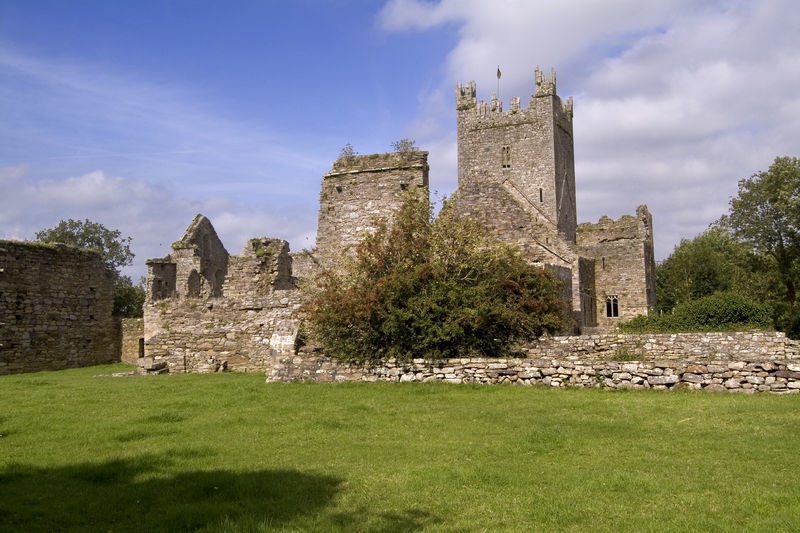
Jerpoint Abbey, Co. Kilkenny
Founded in 1180, Jerpoint Abbey stands as a captivating relic of Ireland's rich monastic heritage. While time has weathered its once-majestic structure, the abbey still boasts impressive remnants of its original twelfth-century Romanesque architecture, including robust pillars and a beautifully preserved medieval chancel.
Visitors to Jerpoint Abbey can marvel at a diverse array of intriguing grave monuments spanning from the thirteenth to the sixteenth centuries, each bearing silent witness to the lives and legacies of those who once walked its hallowed grounds. However, what truly sets Jerpoint Abbey apart is its exceptional cloister arcade – adorned with intricately carved, largely secular figures that offer a fascinating glimpse into the fashion and armor of fifteenth and sixteenth-century Ireland.
Today, Jerpoint Abbey continues to exude a serene and contemplative ambiance, inviting visitors to immerse themselves in its timeless tranquility and experience a profound connection with Ireland's storied past. Whether you're a history enthusiast, a spiritual seeker, or simply a traveler in search of hidden gems, Jerpoint Abbey promises an unforgettable journey through centuries of history, art, and culture.
Overnight: Mount Juliet Estate or Butler House
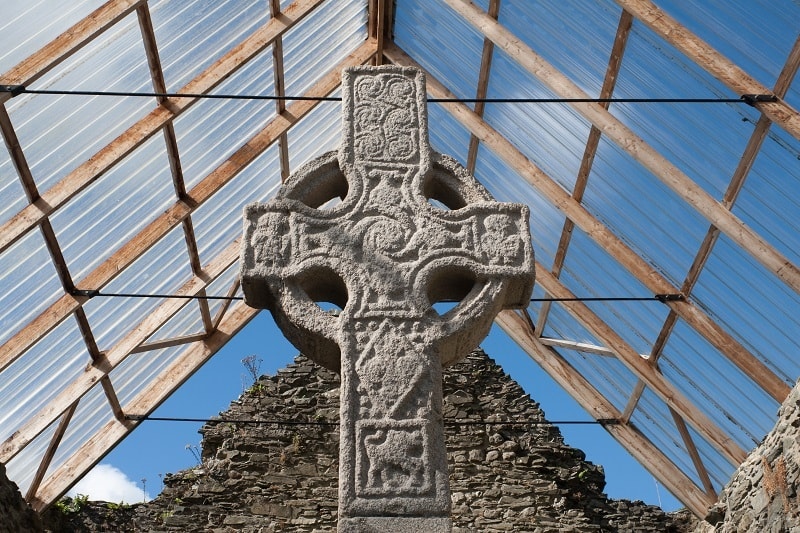
Moone High Cross, Co. Kildare
Nestled in the tranquil landscapes of Co. Kildare, the Moone High Cross stands as a remarkable testament to Ireland's rich religious and artistic heritage. Ranking as the second tallest High Cross in the country, this iconic monument boasts a distinctive three-part design that captivates visitors with its unique shape and intricate craftsmanship.
Originally discovered in fragments in the abbey graveyard in 1835, the cross underwent a fascinating journey of restoration and reconstruction. After the middle section of the shaft was unearthed in 1893, the cross was meticulously reassembled to its original grandeur, now towering at an impressive height of 17.5 feet within the medieval church ruins.
Believed to have been founded by St. Palladius in the fifth century and dedicated to St. Columcille in the sixth century, the Moone High Cross is constructed from durable granite and dates back to the eighth century. This ancient monument serves as a powerful symbol of Ireland's enduring faith and cultural heritage, inviting visitors to explore its rich history, marvel at its exquisite craftsmanship, and reflect on the spiritual significance that has resonated through the ages.
Overnight: Rathsallagh House or Barberstown Castle
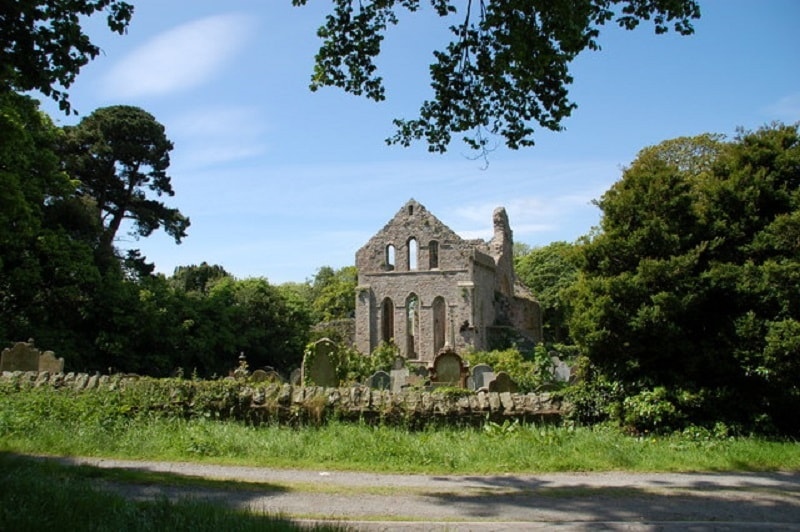
Grey Abbey, Co. Down
Nestled amidst the picturesque landscapes of Northern Ireland, the ruins of Greyabbey stand as a splendid tribute to Anglo-Norman ecclesiastical architecture. Founded in 1193 by Affreca, daughter of Godfred, King of Man, and wife of John de Courcy – the Anglo-Norman invader of East Ulster – this Cistercian Abbey has captivated visitors for centuries with its breathtaking beauty and historical significance.
Colonized by Cistercian monks from Cumbria, the union of French Cistercian influences and English craftsmanship gave rise to Greyabbey's distinctive Gothic design. Boasting tall pointed lancet windows and intricate architectural details, Greyabbey is recognized as the first truly Gothic structure in Ireland, showcasing a harmonious blend of European styles and local craftsmanship.
Today, the majestic ruins of Greyabbey invite visitors to step back in time and explore the rich tapestry of history, art, and culture that defines this remarkable site. Whether you're a history enthusiast, an architecture aficionado, or simply a traveler seeking to uncover hidden gems, Greyabbey promises an unforgettable journey through Northern Ireland's storied past and the enduring legacy of its Gothic architectural heritage.
Overnight: Newforge House or The Old Inn
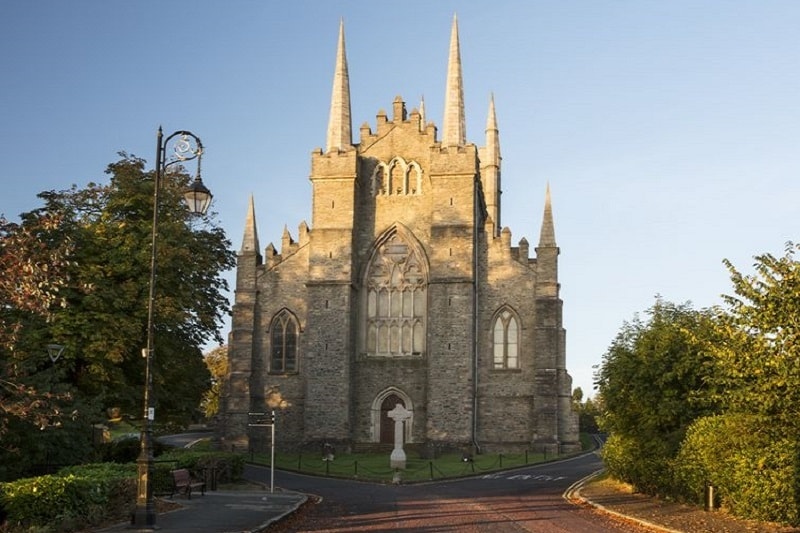
Down Patrick Cathedral and St. Patrick's Grave, Co. Down
Located on the ancient hill of Down, Downpatrick holds a revered place in the heart of Ireland's spiritual landscape. Saint Patrick, the Patron Saint of Ireland, is said to have visited the area multiple times, preaching at Saul, seeking solace at the Struell Wells, and receiving his final rites from Saint Tassach in Raholp. Today, the tranquil surroundings of Downpatrick Cathedral stand as a testament to this rich history, believed to be the final resting place of Saint Patrick himself.
Built in 1183 by John de Courcy for Benedictine monks from Chester, Downpatrick Cathedral has become a beacon of pilgrimage for believers and history enthusiasts alike. The cathedral's sacred grounds are believed to also house the remains of Saint Brigid and Saint Columba, further enhancing its spiritual significance and drawing pilgrims from far and wide.
Every March, the pilgrimage to Downpatrick reaches its peak as visitors flock to view the massive granite stone that marks Saint Patrick's reputed grave. Here, amidst the serene beauty of Downpatrick, pilgrims leave wreaths as a mark of respect and reverence to Ireland's beloved Patron Saint, forging a timeless connection with the land, its history, and the enduring legacy of Saint Patrick's faith and teachings.
Overnight: Newforge House or The Old Inn
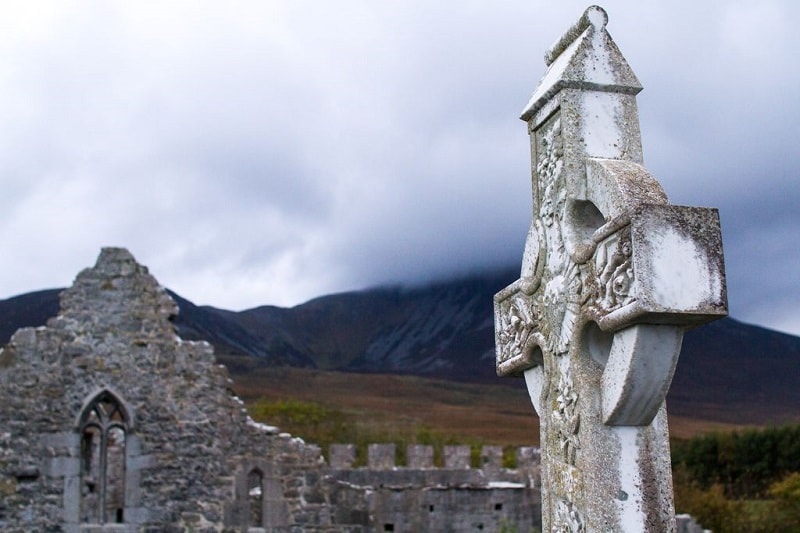
Croagh Patrick, Co. Mayo
Perched majestically on the rugged landscapes of County Mayo, Croagh Patrick has been a revered site long before the dawn of Christianity. This sacred mountain was once a principal location for the harvest festival of Lughnasa, where women ascended to the summit to seek blessings of fertility and abundance from the ancient gods.
In Christian tradition, Croagh Patrick holds a special place in the legacy of Saint Patrick, Ireland's beloved Patron Saint. Legend has it that Saint Patrick spent forty days and nights atop this sacred peak, bravely banishing snakes, dragons, and pagan demons, marking the triumph of Christian faith over ancient beliefs.
Today, Croagh Patrick continues to captivate the hearts and minds of pilgrims from around the world. Each year, nearly one million devotees undertake the challenging ascent to the summit, with as many as 40,000 making the pilgrimage on the last Sunday in July, a tradition observed by many as a sacred act of penance. Many choose to walk barefoot, following in the footsteps of countless pilgrims before them, forging a deep connection with the land and its rich tapestry of history, spirituality, and enduring faith.
Whether you are drawn to the ancient rituals of Lughnasa or the Christian pilgrimage of Saint Patrick, Croagh Patrick invites you to embark on a transformative journey of discovery, reflection, and spiritual renewal amidst the breathtaking beauty of Ireland's mystical landscapes.
Overnight: Enniscoe House, Belleek Castle or The Ice House
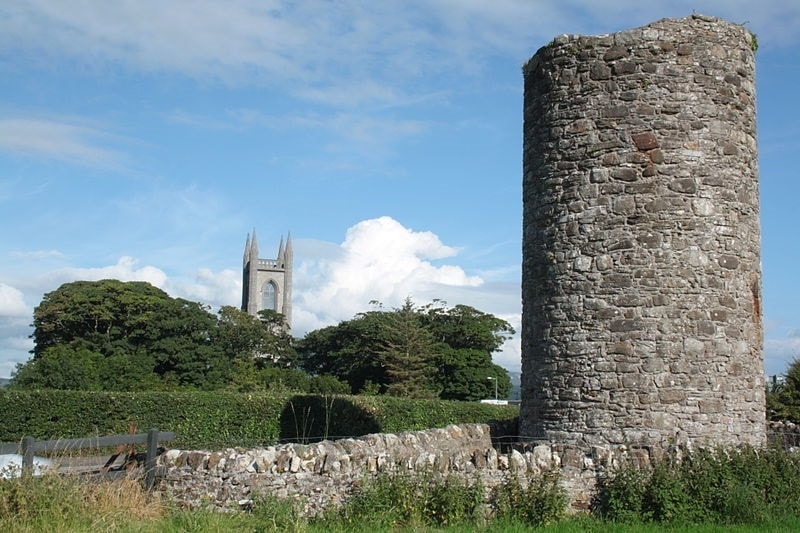
Drumcliffe, Co. Sligo
Nestled in the verdant landscapes of County Sligo, Drumcliffe holds a special place in the annals of Irish history and literature, closely associated with the revered Saint Columba, also known as Colm Cille. The pathway leading to the quaint church and the final resting place of the renowned poet W.B. Yeats is graced by a magnificent sandstone high cross, a testament to the region's rich cultural heritage.
This splendid high cross, crafted from warm sandstone, is a masterpiece of ancient craftsmanship, adorned with intricate carvings of fascinating animals in high relief on both the shafts and the head of the cross. The east face of the cross narrates biblical tales, depicting scenes of Adam and Eve, David slaying Goliath, and Daniel in the Lions' Den. While the panels on the west face, though more challenging to decipher, are believed to portray New Testament subjects.
The sides of the cross, punctuated with holes possibly for a long-lost arm support, showcase mesmerizing spirals and interlace patterns, adding to its artistic allure. Notably, the Virgin and Child grace the end of the south arm, making their only solo appearance on an Irish high cross.
Though often dated to the eleventh century, the true origins of this remarkable cross may well extend further back in time, adding to its enigmatic charm and enduring appeal. Drumcliffe invites you to step back in time, to explore its ancient treasures, and to pay homage to the literary genius of W.B. Yeats, all amidst the tranquil beauty of Ireland's captivating countryside.
Overnight: Coopershill House
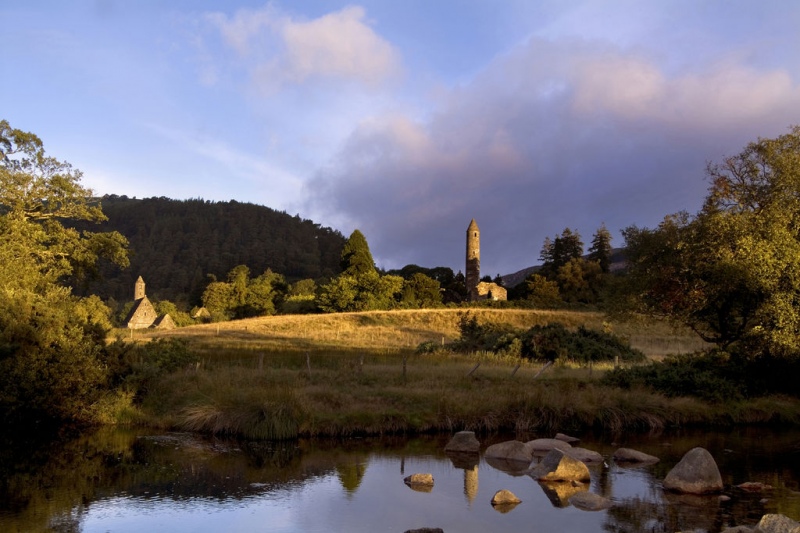
Glendalough, Co. Wicklow
Nestled in the picturesque landscapes of County Wicklow, Glendalough is a place steeped in ancient history and spiritual significance, drawing pilgrims and visitors alike to its hallowed grounds for centuries. The famed Seven Churches of Glendalough stand as a testament to its enduring legacy as a revered pilgrimage site, recognized as the final resting place for the Kings of Leinster.
St. Kevin, a revered figure of Irish spirituality, sought solace in the tranquil surroundings of Glendalough, living a life of hermitic seclusion. However, his profound wisdom and sanctity soon attracted a devoted following, prompting the establishment of a vibrant monastic city to accommodate the growing community of believers.
Today, the remnants of this illustrious past continue to captivate visitors, with the majestic cathedral, the iconic round tower, and the enchanting St. Kevin's Kitchen standing as enduring symbols of Glendalough's rich heritage and spiritual significance. As you wander through this ancient sanctuary, you'll be transported back in time, connecting with the timeless spirit of devotion and reverence that has permeated Glendalough's sacred landscapes for generations.
Overnight: Hunter's Hotel, Rathsallagh House or The Wicklow Escape
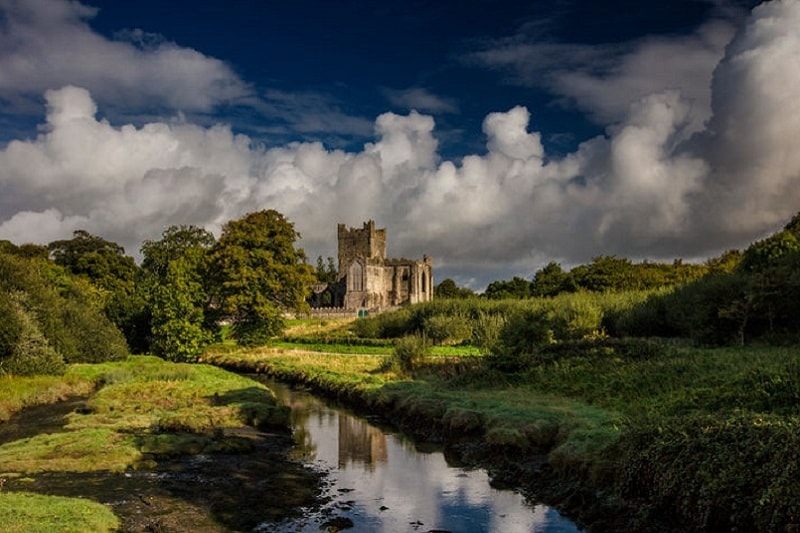
Tintern Abbey, Co. Wexford
Situated on the serene shores of County Wexford, Tintern Abbey stands as a poignant reminder of Ireland's rich ecclesiastical heritage. Founded around 1200 by William the Earl Marshall and named after its Welsh counterpart, this Cistercian Abbey has witnessed centuries of change, yet its enduring spirit remains intact.
The architectural splendour of Tintern Abbey is evident in its well-preserved remains, which include a majestic nave, an elegant chancel, a stately tower, a tranquil chapel, and a serene cloister. Over the years, the abbey underwent various transformations, with parts of it being converted into living quarters after 1541, reflecting the evolving needs and lifestyles of its inhabitants.
The abbey's history took a familial turn in the 16th century when it was occupied by the Colclough family, who called this historic site home for over four centuries until the 1960s. Their legacy is interwoven with the fabric of Tintern Abbey, adding a personal touch to its storied past.
Today, as you explore the atmospheric ruins of Tintern Abbey, you'll be transported back in time, discovering the intricate details of its architecture and the compelling stories of the people who shaped its history. It's a place where the echoes of the past resonate with the present, inviting visitors to connect with the timeless spirit of faith, heritage, and family that defines Tintern Abbey.
Overnight: Dunbrody House Hotel or Marlfield House